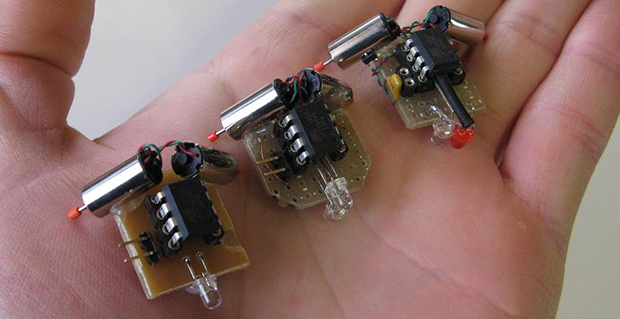Back in the late 80s and early 90s, a lot of young electronics hobbyists cut their teeth with BEAM robots – small robots made with logic chips and recycled walkmans that tore a page from papers on neural nets and the AI renaissance of the 80s. Twenty years later, a second AI renaissance never happened because a generation of genius programmers decided the best use of their mental faculties was to sell ads on the Internet. We got the Arduino, though, and the tiny robot family is a more than sufficient spiritual successor to the digital life of the old BEAM bots.
The tiny robot family is [shlonkin]’s growing collection of small autonomous vehicles that perceive the world with sensors and act with different behaviors. They all contain an ATtiny85, a small battery, two motors, and at least one phototransistor and a LED. One robot has left and right eyes pointing down, and can act as a line follower. Another has a group of LEDs around its body, allowing it to signal other bots in all directions. The goal of the project is to create a whole series of these tiny robots capable of interacting with the environment and each other. Video of the line follower below.
















Note if you want it to be easier for the kids to program use a PicAxe for the processor. a lot easier for the kids to grasp, plus the emulator let’s them play with it on the PC first.
Honestly, a good school would have a bunch of boards made and get the parts together so a whole class can make these for electronics/CS. Because programming a robot is far more educational than having them parked in front of a montor abusing the kids with Visual studio making pixels move.
You are not allowed to use a soldering iron in school without a proper training.
when I was in school (UK) I was able to use a soldering iron without “proper training”, though we were supervised (which is to be expected)
“Honestly, a good school would have a bunch of boards made and get the parts together so a whole class can make these for electronics/CS.”
+2
Hackaday needs a separate section for cute bots. These things are adorable.
That line follower one is like an ant!
“genius programmers decided the best use of their mental faculties was to sell ads on the Internet.” Haha, you’re probably right, although (genius or not) I suppose we’re guilty of that as well!
Cool ‘bot though – wish it showed the other ‘bots following the first in the video!
Here is a very simple line “robot”. I guess there is no need to understand German.
http://www.heise.de/hardware-hacks/projekte/Simpelmobil-Robot-Spurt-1745722.html
http://www.youtube.com/watch?v=Sqq892SMUrA
That’s pretty cool.
Super project!!! Very clever bots!
“An” LED, please.
ANti grammar police?
“genius programmers decided the best use of their mental faculties was to sell ads on the Internet.”
This one struck me personally ;) : I have a PhD in AI and was selling ringtones and other crap online for a while.
Don’t take it personally. The other geniuses were working to shave microseconds from share trading transactions.
I was a great fan of BEAM robots until I realized that they were very limited in what they could do without going to much larger control circuits and actuator assemblies. How about throwing a challenge here to actually get these to communicate/swarm (cf. Robot 2) and still remain small/simple/cheap? The physical size difference between the Atmel chips isn’t much and their capabilities are enormous, so all that’s left is to whittle the actuators & sensors down to size.
http://en.wikipedia.org/wiki/Swarm_robotics
cool! but where can i get these nice motors?
source anyone?
nevermind, found the answer in the BOM.
Unfortunately, technology, mostly those throwing around the term artificial intelligence/smart machine(s), have what I call a “vestigial recursive factor” or “Technological Circle of Life”, where someone may have an idea for an artificial (intelligent) machine once thought of original only to find it’s been done ten to twenty years hence and carried the fore thought “in twenty years this technology will become available to everyone”, (the first self-driving vehicle, the Hardi-man, and all manner of robots past and current), all for naught because it fails/falls under the repetitive, ” a new way to do an old thing…every ten-twenty years. The proverbial “Circle of life” for all manner of technology That is why I prefer the term Artificial Conveyance or Convenience when considering accountability
“Everything the artificial light touches is where repeated technology will be created”